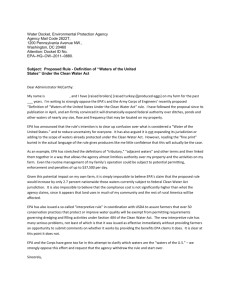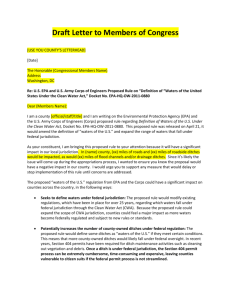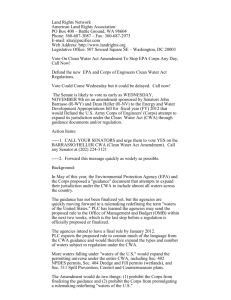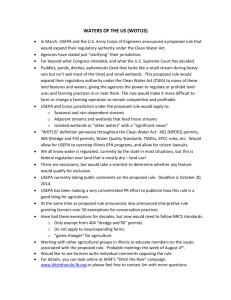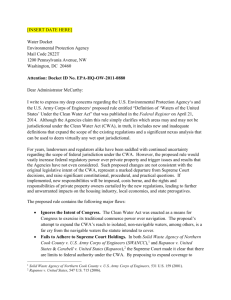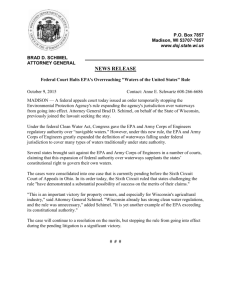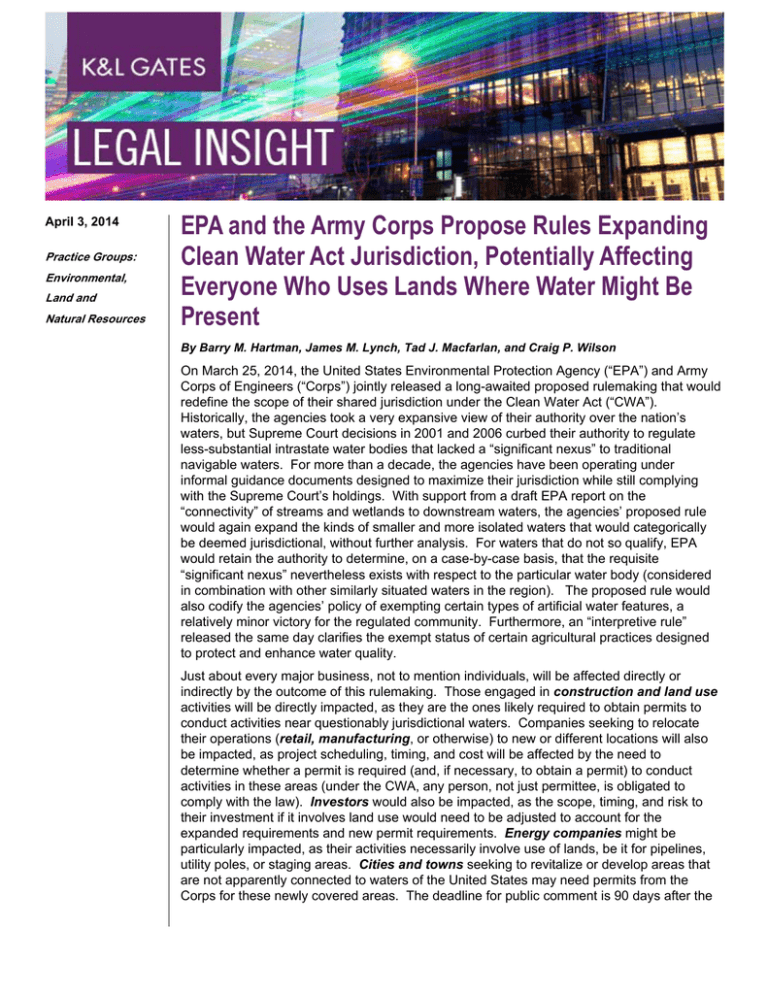
April 3, 2014
Practice Groups:
Environmental,
Land and
Natural Resources
EPA and the Army Corps Propose Rules Expanding
Clean Water Act Jurisdiction, Potentially Affecting
Everyone Who Uses Lands Where Water Might Be
Present
By Barry M. Hartman, James M. Lynch, Tad J. Macfarlan, and Craig P. Wilson
On March 25, 2014, the United States Environmental Protection Agency (“EPA”) and Army
Corps of Engineers (“Corps”) jointly released a long-awaited proposed rulemaking that would
redefine the scope of their shared jurisdiction under the Clean Water Act (“CWA”).
Historically, the agencies took a very expansive view of their authority over the nation’s
waters, but Supreme Court decisions in 2001 and 2006 curbed their authority to regulate
less-substantial intrastate water bodies that lacked a “significant nexus” to traditional
navigable waters. For more than a decade, the agencies have been operating under
informal guidance documents designed to maximize their jurisdiction while still complying
with the Supreme Court’s holdings. With support from a draft EPA report on the
“connectivity” of streams and wetlands to downstream waters, the agencies’ proposed rule
would again expand the kinds of smaller and more isolated waters that would categorically
be deemed jurisdictional, without further analysis. For waters that do not so qualify, EPA
would retain the authority to determine, on a case-by-case basis, that the requisite
“significant nexus” nevertheless exists with respect to the particular water body (considered
in combination with other similarly situated waters in the region). The proposed rule would
also codify the agencies’ policy of exempting certain types of artificial water features, a
relatively minor victory for the regulated community. Furthermore, an “interpretive rule”
released the same day clarifies the exempt status of certain agricultural practices designed
to protect and enhance water quality.
Just about every major business, not to mention individuals, will be affected directly or
indirectly by the outcome of this rulemaking. Those engaged in construction and land use
activities will be directly impacted, as they are the ones likely required to obtain permits to
conduct activities near questionably jurisdictional waters. Companies seeking to relocate
their operations (retail, manufacturing, or otherwise) to new or different locations will also
be impacted, as project scheduling, timing, and cost will be affected by the need to
determine whether a permit is required (and, if necessary, to obtain a permit) to conduct
activities in these areas (under the CWA, any person, not just permittee, is obligated to
comply with the law). Investors would also be impacted, as the scope, timing, and risk to
their investment if it involves land use would need to be adjusted to account for the
expanded requirements and new permit requirements. Energy companies might be
particularly impacted, as their activities necessarily involve use of lands, be it for pipelines,
utility poles, or staging areas. Cities and towns seeking to revitalize or develop areas that
are not apparently connected to waters of the United States may need permits from the
Corps for these newly covered areas. The deadline for public comment is 90 days after the
EPA and the Army Corps Propose Rules Expanding Clean
Water Act Jurisdiction, Potentially Affecting Everyone Who
Uses Lands Where Water Might Be Present
rule is published in the federal register; all stakeholders should seriously consider their
options for participation in the rulemaking process.
Background
The core of the modern Clean Water Act is its prohibition of the discharge of “pollutants” into
“navigable waters” by “point sources” without a permit issued by either EPA or the Corps.i
The Corps is the lead permitting agency for discharges of dredged or fill material under
Section 404 of the CWA, while EPA issues permits for the discharge of other pollutants
under the Section 402 national pollutant discharge elimination system (“NPDES”) program.ii
EPA retains enforcement authority over all types of pollutant discharges.
Importantly, the CWA only provides the agencies with jurisdiction over “navigable waters,”
which the statute later defines as “the waters of the United States, including the territorial
seas.”iii The scope of the agencies’ jurisdiction pursuant to these terms has been the subject
of a great deal of uncertainty and litigation, especially over areas commonly called
“wetlands.” Existing Corps and EPA regulations (last updated in 1986) adopt an
interpretation that would grant the agencies authority over essentially all waters that the U.S.
Constitution would arguably permit, regardless of limits imposed by the CWA itself.iv The
constitutional authority is derived from the interstate commerce clause, which the Supreme
Court has interpreted (broadly) to provide the federal government with authority over all
matters that “substantially affect” interstate commerce.v
In 2001, the Supreme Court struck a first blow to the outer reaches of the agencies’
expansive jurisdictional interpretation. In Solid Waste Agency of Northern Cook County v.
U.S. Army Corps of Engineers (“SWANCC”), the Court held that the Corps had no
jurisdiction over an abandoned sand and gravel pit merely because migratory (i.e., interstate)
birds used the site as habitat.vi Lower courts interpreted SWANCC in radically different
ways. For instance, the Fifth Circuit indicated that SWANCC limited jurisdiction to bodies of
water that were either actually navigable or adjacent to navigable waters.vii The Ninth
Circuit read SWANCC more narrowly as a rejection only of the “migratory bird rule” that was
implicated in the case.viii As a prelude of things to come, the Fourth Circuit keyed in on
language from SWANCC suggesting that the agencies had jurisdiction over all waters that
had a “significant nexus” to navigable waters, deferring to the Corps’ position that the entire
tributary system was jurisdictional.ix
Five years later, in 2006, the Supreme Court again addressed the scope of CWA jurisdiction
in Rapanos v. United States (“Rapanos”).x While a majority of the Court could not agree on
a single interpretive position, most commentators agree that the deciding vote belonged to
Justice Kennedy, who held that, in order for a water to be regulated under the CWA, it “must
possess a ‘significant nexus’ to waters that are or were navigable in fact or that could
reasonably be so made.”xi A plurality opinion, signed by four of the Court’s justices, would
have interpreted the CWA more narrowly to apply only to “relatively permanent, standing or
continuously flowing bodies of water” connected to traditional navigable waters, and to
“wetlands with a continuous surface connection to” such relatively permanent waters.xii
Since Rapanos, the agencies have taken the position (via guidance document) that any
water satisfying either the Kennedy “significant nexus” test or the pluralities’ test qualifies as
jurisdictional.xiii In most (if not all) cases, a water that has a “significant nexus” would also
pass the pluralities’ test, but it is more straightforward and less resource-intensive for the
agencies to establish that a water is jurisdictional under the pluralities’ test. The agencies’
2
EPA and the Army Corps Propose Rules Expanding Clean
Water Act Jurisdiction, Potentially Affecting Everyone Who
Uses Lands Where Water Might Be Present
currently effective 2008 guidance also establishes the following classes of waters that are
categorically considered to be jurisdictional under the Rapanos tests:
•
Traditional navigable waters
•
Wetlands adjacent to traditional navigable waters
•
Non-navigable tributaries of traditional navigable waters that are relatively
permanent where the tributaries typically flow year-round or have continuous flow at
least seasonally (e.g., typically three months)
•
Wetlands that directly abut such tributaries
The agencies assert jurisdiction over these classes of waters without further analysis.
Jurisdiction over other waters is currently determined on a case-by-case basis under the
“significant nexus” test, which is described in a general way in the 2008 guidance.
The Connectivity Report
In September 2013, EPA released a draft report summarizing peer-reviewed scientific
literature on the connectivity of streams and wetlands relative to large water bodies such as
rivers, lakes, estuaries, and oceans (the draft “Connectivity Report”).xiv This report is
intended to provide a scientific basis for the blanket assertion of jurisdiction over additional
categories of waters under Justice Kennedy’s “significant nexus” test, so that the agencies
can dispense with the administrative burden of establishing such a connection on a case-bycase basis. The draft Connectivity Report’s major conclusions are:
•
All tributary streams, including perennial, intermittent, and ephemeral streams, are
physically, chemically, and biologically connected to downstream rivers.
•
Wetlands and open waters in riparian areas and floodplains are physically,
chemically, and biologically connected with downstream rivers.
•
Current literature is insufficient to generalize about the connectivity or downstream
effects of isolated wetlands.
EPA is continuing to accept public comments on the draft Connectivity Report while a panel
of the EPA Scientific Advisory Board (“SAB”) performs a mandatory quality review (a future
federal register notice will establish a final closing date for comments). The report has not
yet been submitted to or approved by the chartered SAB or the EPA Administrator. Some
have questioned whether it is appropriate for EPA to base its proposed rulemaking on
preliminary conclusions in a report that has not been vetted and finalized. EPA’s response is
that any rulemaking will not be finalized until the final version of the scientific assessment is
complete. Whether the agency can take comment on a proposal before that assessment is
complete and then finalize the rule based on a final assessment that is not subject to further
public comment is an open question.
Proposed Rule
On March 25, 2014, the agencies released their proposed rulemaking to amend the
regulatory definition of “waters of the United States.” Relying heavily on the findings from the
draft Connectivity Report, the proposed rule would establish that the following classes of
waters—in addition to those identified in the 2008 guidance—are always jurisdictional:
3
EPA and the Army Corps Propose Rules Expanding Clean
Water Act Jurisdiction, Potentially Affecting Everyone Who
Uses Lands Where Water Might Be Present
•
All “tributaries” (not just those that are relatively permanent) of downstream
traditional navigable waters, interstate waters, or the territorial seas. The rule would
broadly define “tributaries” to include any water (including wetlands, lakes, and
ponds) that contributes flow, either directly or through another water, to these more
substantial downstream waters.
•
All waters that are “adjacent” to such tributaries. The rule would broadly define
“adjacent” to include all waters located within the “riparian area” or “floodplain” of
jurisdictional waters, in addition to waters with a shallow subsurface hydrologic
connection or confined surface hydrologic connection to jurisdictional water.
This proposal may substantially reduce the use of the Corps’ 1987 “Wetlands Delineation
Manual”xv to establish whether remote waters are jurisdictionally connected by “wetlands” to
downstream traditional navigable waters. The agencies created the 1987 Manual to provide
science-based criteria for making wetland determinations. Both the agencies and the
regulated community have used it when controversies exist over whether an area not
obviously connected to "waters of the United States" is nonetheless jurisdictional because it
is near a wetland that has an appropriate hydrological connection to other waters of the
United States. In many cases the Corps or EPA has found itself unable to rely on the
Manual to assert jurisdiction in the face of scientific evidence developed consistent with the
Manual and presented by the potentially regulated parties. The proposed rule would likely
reduce the use of the Manual substantially in this regard by bringing many of those
questionable areas within jurisdiction by rule, with parties unable to contest it. Whether the
certainty of expanding jurisdiction is beneficial remains to be seen. It will likely reduce the
amount of human activity that may take place in these questionable areas because permits
will be denied. It will also increase the cost of activity that is permitted based on conditions
associated with the permit. Whether these new rules are based on sound science is also a
question that comments are likely to address. Either way, it will certainly reduce the use of
the Manual and replace case-by-case science with a rule.
All other waters (with limited exceptions mentioned below) would continue to be evaluated on
a case-by-case basis under the significant nexus test. The rule would define the term
“significant nexus” in a way that generally comports with current practice under the 2008
guidance, tracking key language from Justice Kennedy’s opinion in Rapanos:
The term significant nexus means that a water, including wetlands, either
alone or in combination with other similarly situated waters in the region . . .
significantly affects the chemical, physical, or biological integrity of a
[traditional navigable water, interstate water, or territorial sea]. For an effect
to be significant, it must be more than speculative or insubstantial. Other
waters, including wetlands, are similarly situated when they perform similar
functions and are located sufficiently close together or sufficiently close to a
“water of the United States” so that they can be evaluated as a single
landscape unit with regard to their effect on the chemical, physical, or
biological integrity of a [traditional navigable water, interstate water, or
territorial sea].xvi
The proposed rule may provide some relief to the regulated community in the form of
categorical exemptions for the following water features:
4
EPA and the Army Corps Propose Rules Expanding Clean
Water Act Jurisdiction, Potentially Affecting Everyone Who
Uses Lands Where Water Might Be Present
•
Ditches that are excavated wholly in uplands, drain only uplands, and have less than
perennial flow
•
Ditches that do not contribute flow, either directly or through another water, to
traditional navigable waters, interstate waters, or the territorial seas
•
Artificially irrigated areas that would revert to upland should application of irrigation
water to that area cease
•
Artificial lakes or ponds created by excavating and/or diking dry land and used
exclusively for such purposes as stock watering, irrigation, settling basins, or rice
growing
•
Artificial reflecting pools or swimming pools created by excavating and/or diking dry
land
•
Small ornamental waters created by excavating and/or diking dry land for primarily
aesthetic reasons
•
Water-filled depressions created incidental to construction activity
•
Groundwater, including groundwater drained through subsurface drainage systems
•
Gullies and rills and non-wetland swales
Most of these water features are currently considered non-jurisdictional as a matter of policy,
but the agencies have, until now, reserved the right to assert jurisdiction over these features
on a case-by-case basis.xvii Arguably, the rule would eliminate the agencies’ discretion to do
so. However, the inclusion of these exemptions in the rulemaking raises a host of new
questions, for which agency discretion is not necessarily constrained. For example, who has
the burden of proving that the exemption does or does not apply? If a feature does not quite
fit within the exemption—a “near miss”—will it be regarded as an implicit and unrebuttable
recognition of jurisdictional status? For instance, if a landowner installs an ornamental water
for some non-aesthetic reason, does that imply that the feature is jurisdictional? Does the
landowner need to prove that the ornamental water is “small,” and if so, what does “small”
mean?
Finally, simultaneous with the release of the proposed rule, the agencies issued an
“interpretive rule” regarding the applicability of CWA § 404(f)(l)(A). This statutory provision
establishes an exemption from permitting requirements for the discharge of dredged or fill
material “from normal farming, silviculture and ranching activities, such as plowing, seeding,
cultivating, minor drainage, harvesting for the production of food, fiber, and forest products,
or upland soil and water conservation practices.”xviii The new interpretive rule indicates that
discharges associated with specific Natural Resources Conservation Service (“NRCS”)
conservation practices (listed by practice number in a separate document) are exempted
from permitting requirements as “normal farming” activities under CWA § 404(f)(l)(A). It is
unclear whether discharges associated with other NRCS conservation practices can still
qualify for the exemption on a case-by-case basis, now that the agencies’ general policy has
been converted to an “interpretive” rule. This interpretive rule, which was developed in
coordination with the Department of Agriculture, has already been signed by EPA and the
Corps and became effective immediately.
5
EPA and the Army Corps Propose Rules Expanding Clean
Water Act Jurisdiction, Potentially Affecting Everyone Who
Uses Lands Where Water Might Be Present
Conclusion
If promulgated in its current form, not only would this rulemaking expand upon the agencies’
already broad jurisdictional interpretations, but it would also likely provide their existing
policies and practices with the legal protections afforded to a duly promulgated rule (such as
entitlement to Chevron deference if challenged).
The agencies have specifically requested comment on several key aspects of the proposed
rule, including (1) the parameters of the case-by-case significant nexus test, and (2)
identifying additional classes of waters that might categorically be deemed jurisdictional or
non-jurisdictional, though comments need not be limited to the issues framed by the
agencies. The regulated community, which encompasses a variety of stakeholders with
multifaceted interests, should use this opportunity to strategically present their arguments to
EPA and the Corps in a way that is both scientifically and legally justifiable. This rulemaking
presents perhaps the best opportunity yet to provide clarity to an area of the law that has for
too long confounded Congress, courts, state and federal agencies, and industry alike.
Authors:
Barry M. Hartman
barry.hartman@klgates.com
+1.202.778.9338
James M. Lynch
jim.lynch@klgates.com
+1.206.370.6587
Tad J. Macfarlan
tad.macfarlan@klgates.com
+1.717.231.4513
Craig P. Wilson
craig.wilson@klgates.com
+1.717.231.4509
Anchorage Austin Beijing Berlin Boston Brisbane Brussels Charleston Charlotte Chicago Dallas Doha Dubai Fort Worth Frankfurt
Harrisburg Hong Kong Houston London Los Angeles Melbourne Miami Milan Moscow Newark New York Orange County Palo Alto Paris
Perth Pittsburgh Portland Raleigh Research Triangle Park San Diego San Francisco São Paulo Seattle Seoul Shanghai Singapore Spokane
Sydney Taipei Tokyo Warsaw Washington, D.C. Wilmington
K&L Gates practices out of 48 fully integrated offices located in the United States, Asia, Australia, Europe, the Middle East and South
America and represents leading global corporations, growth and middle-market companies, capital markets participants and
entrepreneurs in every major industry group as well as public sector entities, educational institutions, philanthropic organizations and
individuals. For more information about K&L Gates or its locations, practices and registrations, visit www.klgates.com.
This publication is for informational purposes and does not contain or convey legal advice. The information herein should not be used or relied upon in
regard to any particular facts or circumstances without first consulting a lawyer.
©2013 K&L Gates LLP. All Rights Reserved.
6
EPA and the Army Corps Propose Rules Expanding Clean
Water Act Jurisdiction, Potentially Affecting Everyone Who
Uses Lands Where Water Might Be Present
i
See 33 U.S.C. §§ 1311, 1362(12).
See 33 U.S.C. §§ 1342, 1344.
33 U.S.C. § 1362(7).
iv
See 33 C.F.R. § 328.3(a); 40 C.F.R. § 230.3(s).
v
U.S. Const. art. I, § 8, cl. 3; U.S. v. Lopez, 514 U.S. 549 (1995). But see National Federation of Independent Business
v. Sebelius, 132 S. Ct. 2566 (2012).
vi
Solid Waste Agency of Northern Cook County v. U.S. Army Corps of Engineers, 531 U.S. 159 (2001).
vii
See Rice v. Harken Exploration Co., 250 F.3d 264, 269 (5th Cir. 2001).
viii
See Headwaters, Inc. v. Talent Irrigation Dist., 243 F.3d 526, 533 (9th Cir. 2001).
ix
See United States v. Deaton, 332 F.3d 698, 712 (4th Cir. 2003).
x
Rapanos v. United States, 547 U.S. 715 (2006).
xi
Id. at 759.
xii
Id. at 739-42.
xiii
See EPA-Corps Guidance on “Clean Water Act Jurisdiction Following the U.S. Supreme Court’s Decision
In Rapanos v. United States & Carabell v. United States” (Dec. 2, 2008).
xiv
U.S. Environmental Protection Agency, Connectivity of Streams and Wetlands to Downstream Waters: A Review and
Synthesis of the Scientific Evidence, (External Review Draft Sept. 2013).
xv
http://el.erdc.usace.army.mil/elpubs/pdf/wlman87.pdf.
xvi
See page 328-329 of the pre-publication proposed rule, available at http://www2.epa.gov/uswaters/definition-watersunited-states-under-clean-water-act.
xvii
See 51 Fed. Reg. 41205, 41217 (Nov. 13, 1986).
xviii
33 U.S.C. § 1344(f)(1)(A).
ii
iii
7


